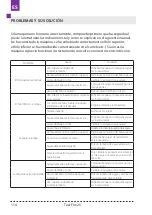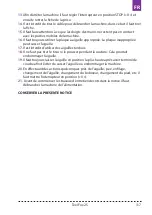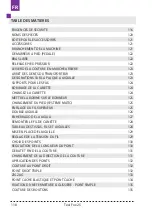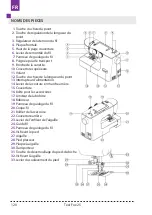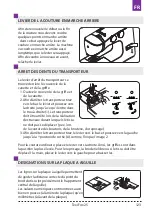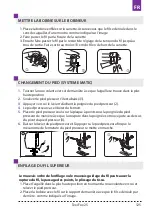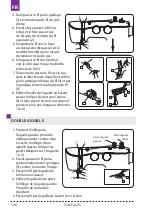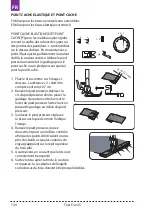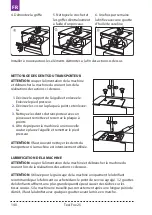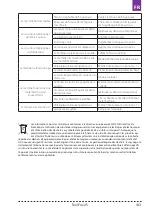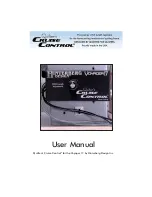
FR
REMONTER LE FIL DE CANETTE
TABLEAU DES TISSUS, FILS ET AIGUILLES
1.
Soulevez le releveur de pied presseur.
2.
Tenir légèrement le fil de l’aiguille et tourner le volant ou appuyer deux fois sur le
bouton de positionnement de l’aiguille. Le volant fera ainsi un tour.
3.
Retirez le fil de l’aiguille. Le fil de canette ressortira sur la plaque à aiguille.
4.
Posez l’extrémité des deux fils sous le pied presseur et faire sortir environ 10 cm.
Sélectionnez un fil et une aiguille dont la grosseur est appropriée au tissu que vous
souhaitez coudre.
N’utilisez qu’une aiguille avec des extrémités appropriées au genre du tissu cousu.
9
KNOWING
YOUR
SEWING
MACHINE
Balancing
top thread
tension
The top thread and the bobbin thread
should interlock in the center of two layers
of fabric in straight seams.
Set the desired number of the thread
tension dial at setting mark.
Loosen the needle thread tension by
moving the dial to a lower number.
Tighten the needle thread tension by
moving the dial to a higher number.
NOTE: In order to obtain better zigzag stitches, the top thread tension should be
slightly weaker than the bobbin thread tension. That means, the top thread
should appear slightly on the reverse side of the fabric, but the bobbin thread
cannot appear on the top side of the fabric.
Drawing up bobbin thread
Raise the presser foot and hold the needle thread lightly
with you left hand.
Turn the hand wheel slowly towards you with your right
hand until the needle goes down and continue turning the
hand wheel until the take-up lever is at its highest
position.
Lightly draw up the needle thread forming a loop of the
bobbin thread.
Pull 15cm (6 inches) of both thread back and under the
presser foot.
③
②
9
KNOWING
YOUR
SEWING
MACHINE
Balancing
top thread
tension
The top thread and the bobbin thread
should interlock in the center of two layers
of fabric in straight seams.
Set the desired number of the thread
tension dial at setting mark.
Loosen the needle thread tension by
moving the dial to a lower number.
Tighten the needle thread tension by
moving the dial to a higher number.
NOTE: In order to obtain better zigzag stitches, the top thread tension should be
slightly weaker than the bobbin thread tension. That means, the top thread
should appear slightly on the reverse side of the fabric, but the bobbin thread
cannot appear on the top side of the fabric.
Drawing up bobbin thread
Raise the presser foot and hold the needle thread lightly
with you left hand.
Turn the hand wheel slowly towards you with your right
hand until the needle goes down and continue turning the
hand wheel until the take-up lever is at its highest
position.
Lightly draw up the needle thread forming a loop of the
bobbin thread.
Pull 15cm (6 inches) of both thread back and under the
presser foot.
③
②
9
KNOWING
YOUR
SEWING
MACHINE
Balancing
top thread
tension
The top thread and the bobbin thread
should interlock in the center of two layers
of fabric in straight seams.
Set the desired number of the thread
tension dial at setting mark.
Loosen the needle thread tension by
moving the dial to a lower number.
Tighten the needle thread tension by
moving the dial to a higher number.
NOTE: In order to obtain better zigzag stitches, the top thread tension should be
slightly weaker than the bobbin thread tension. That means, the top thread
should appear slightly on the reverse side of the fabric, but the bobbin thread
cannot appear on the top side of the fabric.
Drawing up bobbin thread
Raise the presser foot and hold the needle thread lightly
with you left hand.
Turn the hand wheel slowly towards you with your right
hand until the needle goes down and continue turning the
hand wheel until the take-up lever is at its highest
position.
Lightly draw up the needle thread forming a loop of the
bobbin thread.
Pull 15cm (6 inches) of both thread back and under the
presser foot.
③
②
Genre du tissu
Grosseur du fil
Grosseur de
l’aiguille
Léger - crêpe fin, taffetas, soie,
etc.
Coton #120 - 150
Soie #120 - 150
Synthétique#120 - 150
70 – 80
Coton, lin, satin, velours côtelé,
velours
Coton #100 - 120
Soie#100 – 120
Synthétique#100 - 120
80 – 90
Gabardine épaisse, tweed,
denim, velours côtelé
Coton #50 - 80
Soie #50 - 80
Synthétique#50 - 80
90 – 100
Tricot, stretch, tricot, spandex,
jersey
Coton #120 - 150
Soie #120 - 150
80 – 90
Texi Fox 25
128
Summary of Contents for Fox 25
Page 1: ...MULTIFUNCTIONAL SEWING MACHINE 2 A L K J I H G F E D C B 3...
Page 2: ......
Page 5: ...Texi Fox 25 5 CS...
Page 172: ...RU 1 2 3 1 2 3 4 5 6 7 8 9 Texi Fox 25 172...
Page 173: ...RU 10 11 12 13 14 15 16 17 Texi Fox 25 173...
Page 175: ...RU 192 193 193 194 194 194 194 195 195 195 196 196 198 Texi Fox 25 175...
Page 193: ...RU 1 A 2 3 4 5 6 H 3 9 2 3 Machine Setting Texi Fox 25 193...
Page 195: ...RU 4 10 1 2 2 3 D 1 4 S S Machine Setting 10mm 3 8 Wrong side of fabric Texi Fox 25 195...
Page 196: ...RU 4 1 2 3 4 1 2 5 6 Texi Fox 25 196...
Page 197: ...RU 1 3 4 1 2 2 4 6 Texi Fox 25 197...
Page 198: ...RU Texi Fox 25 198...

